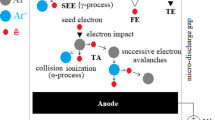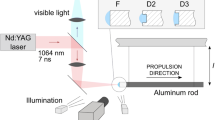Abstract—
The pressure field in the limited-volume discharge chambers with rigid walls very often affects the efficiency of the technological processes, which is an urgent problem. As a result of the electric discharge in the liquid that fills the discharge chamber, a cavity is formed with a compressibility higher than the liquid in the chamber. This cavity is filled at the discharge stage with a nonideal plasma, and, after the discharge, it is filled with a vapor of the liquid and gases dissolved in it (a vapor-gas cavity). Its pulsations form the pressure field in the discharge chamber. A moving boundary of the vapor-gas cavity makes it difficult to calculate the pressure field in the fluid, especially after a great amount of its pulsations. At present, the role of the vapor-gas cavity is studied insufficiently in the formation of the pressure field in the discharge chamber. To determine it is the aim of the work. This research is performed based on the mathematical model of the electrical discharge in water developed earlier, which was supplemented in this article by ratios that substantially enhance the calculation precision of the discharge channel resistance and the energy released in it. It was determined that the vapor-gas cavity pulsations ensure the pressure oscillations in it in the antiphase with the pressure in the liquid. The pulsations decay slowly, therefore a static equilibrium cannot be established in the discharge chamber between the cavity and the liquid that surrounds it even after seven pulsations. The effect of change was determined in the plasma’s optical transparency on the pressure in the cavity and pressure field in the liquid, which decreases the pressure level.













Similar content being viewed by others
REFERENCES
Gulyi, G.A., Nauchnye osnovy razryadno-impul’snykh tekhnologii (Scientific Foundations of the Discharge-Impulse Technologies), Kiev: Naukova Dumka, 1990.
Kurets, V.I., Solov’ev, M.A., Zhuchkov, A.I., and Barskaya, A.V., Elektrorazryadnye tekhnologii obrabotki i razrusheniya materialov (Electrodischarge Processes of Treatment and Destruction of Materials), Tomsk: Tomsk. Politekh. Univ., 2012.
Barbashova, G.A. and Vovchenko, A.I., Surf. Eng. Appl. Electrochem., 2016, vol. 52, no. 2, pp. 176–180.
Barbashova, G.A., Surf. Eng. Appl. Electrochem., 2012, vol. 48, no. 3, pp. 260–263.
Kuskova, N.I., Baklar’, V.Yu., Terekhov, A.Yu., Yushchishina, A.N., et al., Surf. Eng. Appl. Electrochem., 2014, vol. 50, no. 2, pp. 101–105.
Yushchishina, A.N., Kuskova, N.I., and Chelpanov, D.I., Surf. Eng. Appl. Electrochem., 2015, vol. 51, no. 3, pp. 203–207.
Petrichenko, S.V., Listovskii, D.I., and Kuskova, N.I., Surf. Eng. Appl. Electrochem., 2016, vol. 52, no. 2, pp. 134–139.
Kosenkov, V.M. and Bychkov, V.M., Tech. Phys. Lett., 2017, vol. 43, pp. 774–777. https://doi.org/10.1134/S1063785017080223
Rizun, A.R., Denisyuk, T.D., and Domershchikova, A.O., Surf. Eng. Appl. Electrochem., 2017, vol. 53, no. 6, pp. 592–596. https://doi.org/10.3103/S1068375517060096
Malyushevskaya, A.P. and Malyushevskii, P.P., Surf. Eng. Appl. Electrochem., 2016, vol. 52, no. 3, pp. 263–269.
Malyushevskii, P.P., Malyushevskaya, A.P., and Yushchishina, A.N., Surf. Eng. Appl. Electrochem., 2017, vol. 53, no. 4, pp. 383–393.
Kononov, V.Yu. and Rachkov, A.N., Elektron. Obrab. Mater., 2015, vol. 51, no. 1, pp. 118–121.
Gillard, A.J., Golovashchenko, S.F., and Mamutov, A.V., J. Manuf. Process, 2013, vol. 15, no. 2, pp. 201–218.
Golovashchenko, S.F., Gillard, A.J., and Mamutov, A.V., J. Mater. Process. Technol., 2013, vol. 213, pp. 1191–1212.
Melander, A., Delic, A., Bjorkblad, A., Juntunen, P., et al., Int. J. Mater. Form., 2013, vol. 6, pp. 223–231.
Hassannejadasl, A., Daniel, E.G., Golovashchenko, S.F., Javad, S., et al., J. Manuf. Process, 2014, vol. 16, no. 3, pp. 391–404.
Mamutov, V., Golovashchenko, S., and Mamutov, A., in Proc. 13th Int. LS-DYNA Conf., June 8–14, 2014, Detroit, 2014, pp. 1–9.
Rohatgi, A.E., Stephens, V., Davies, R.W., Smith, M.T., et al., J. Mater. Process. Technol., 2012, vol. 212, pp. 1070–1079.
Chachin, V.N., Shaduya, V.L., Zhuravskii, A.Yu., and Zdor, G.N., Elektrogidroimpul’snoe formoobrazovanie s ispol’zovaniem zamknutykh kamer (Electrohydroimpulse Shaping Using Closed Chambers), Minsk: Nauka i Tekhnika, 1985.
Smirnov, A.P., Zhekul, V.G., Mel’kher, Yu.I., et al., Surf. Eng. Appl. Electrochem., 2018, vol. 54, no. 5, pp. 475–480. https://doi.org/10.3103/S1068375518050101
Smirnov, A.P., Zhekul, V.G., and Poklonov, S.G., Surf. Eng. Appl. Electrochem., 2014, vol. 50, no. 3, pp. 233–237.
Vovchenko, A.I., Kucherenko, V.V., and Shamko, V.V., J. Appl. Mech. Tech. Phys., 1978, vol. 19, no. 6, pp. 755–760.
Chachin, V.N., Impul’snye metody obrabotki materialov (Pulsed Methods of Materials Processing), Minsk: Nauka i Tekhnika, 1977, pp. 44–55.
Mamutov, A.V. and Mamutov, V.S., Nauchno-Tekh. Ved. S.-Peterb. Gos. Politekh. Univ., 2014, vol. 190, no. 1, pp. 101–107.
Hassannejadasl, A., Simulation of electrohydraulic forming using anisotropic, rate-dependent plasticity models, PhD Thesis, Windsor, ON: Univ. of Windsor, 2014.
Kosenkov, V.M. and Bychkov, V.M., Surf. Eng. Appl. Electrochem., 2015, vol. 51, no. 2, pp. 167–173.
Kosenkov, V.M., Tech. Phys., 2011, vol. 56, no. 10, p. 1513.
Dubovenko, K.V., Surf. Eng. Appl. Electrochem., 2013, vol. 49, no. 1, pp. 28–35. https://doi.org/10.3103/S1068375513010031
Shneerson, G.A., Tech. Phys., 2003, vol. 48, pp. 374–375.
Titkov, V.V., Tech. Phys. Lett., 2010, vol. 36, no. 8, pp. 687–689.
Goldfarb, V., Budny, R., Dunton, A., Shneerson, G., et al., in Proc. 11th IEEE Int. Pulsed Power Conf., Baltimore, MD, June 29–July 2, 1997, New York, NY: Inst. Electr. Electron. Eng., 1997.
Krivitskii, E.V., Dinamika elektrovzryva v zhidkosti (Dynamics of Electrical Explosion in Liquid), Kiev: Naukova Dumka, 1986.
Krivitskii, E.V. and Shamko, V.V., Perekhodnye protsessy pri vysokovol’tnom razryade v vode (Transition Processes at High-Voltage Discharge in Water), Kiev: Naukova Dumka,1979.
Naugol’nykh, K.A. and Roi, N.A., Elektricheskie razryady v vode (Electric Discharges in Water), Moscow: Nauka, 1971.
Krinberg, I.A., J. Appl. Mech. Tech. Phys., 1965, vol. 6, pp. 98–102.
Feynman, R.P. and Hibbs, A.R.,Quantum Mechanics and Path Integrals, New York: McGraw-Hill, 1965.
Zhdanov, V.M., Yavleniya perenosa v gazakh i plazme (Transport Phenomena in Gases and Plasma), Moscow: Mosk. Inzh.-Fiz. Inst., 2008.
Author information
Authors and Affiliations
Corresponding author
Additional information
Translated by M. Baznat
About this article
Cite this article
Kosenkov, V.M. Effect of a Vapor-Gas Cavity on the Pressure Field in a Limited-Volume Discharge Chamber with Rigid Walls. Surf. Engin. Appl.Electrochem. 57, 197–206 (2021). https://doi.org/10.3103/S1068375521020046
Received:
Revised:
Accepted:
Published:
Issue Date:
DOI: https://doi.org/10.3103/S1068375521020046




